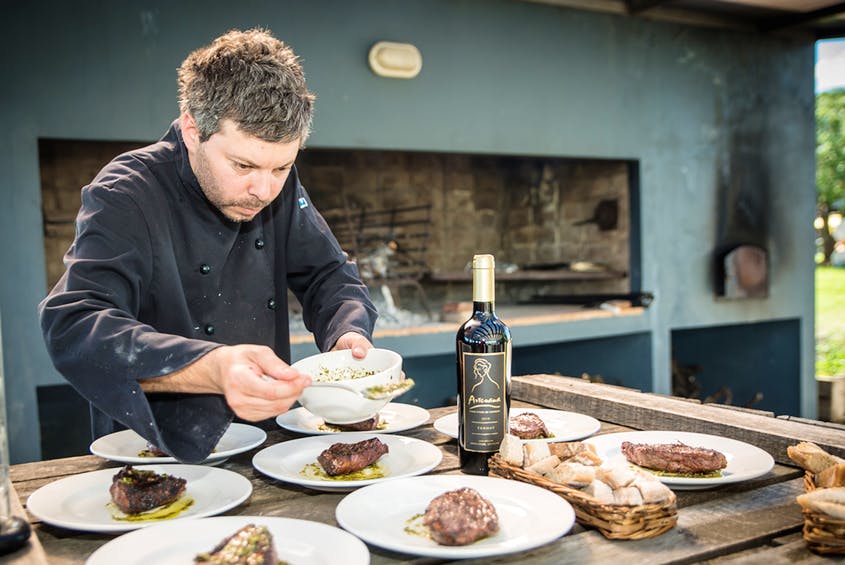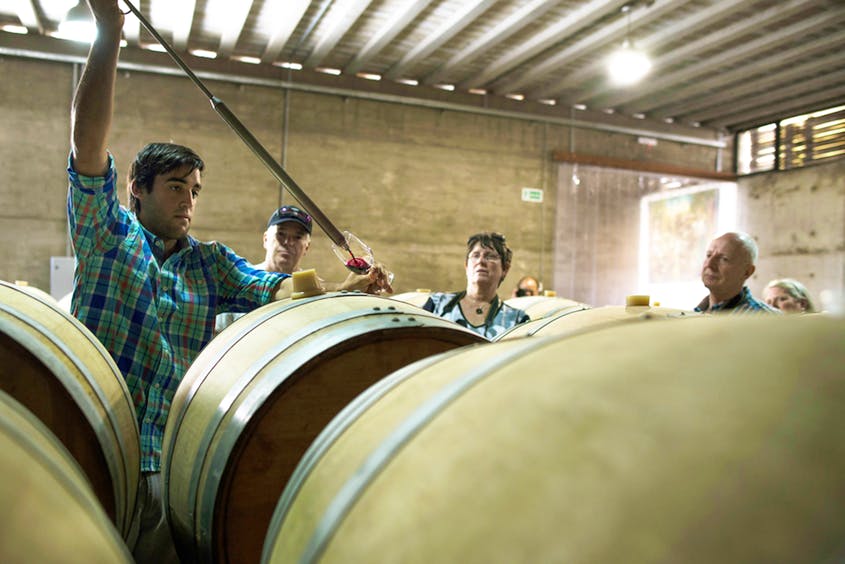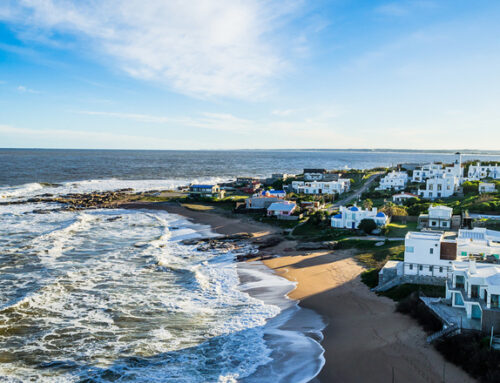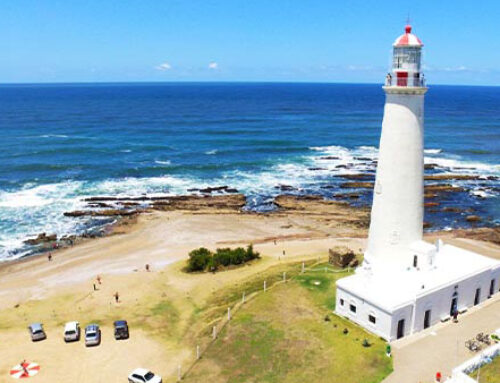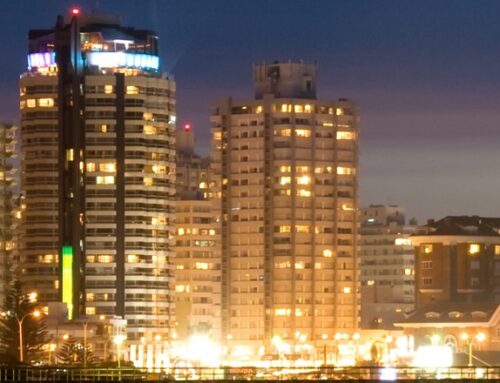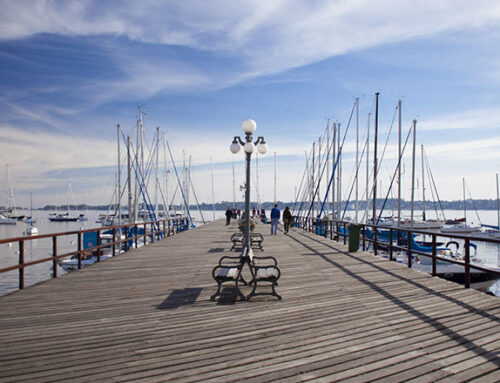Within an hour of busy Montevideo, Uruguay’s fertile Canelones wine region beckons with more than 80 vineyards tucked into its transporting, pastoral setting.
Thoughts of a wine-focused vacation in South America might instantly conjure up images of sipping malbec among the mountains of Mendoza, Argentina’s premier wine region. Or, they might even turn to Chile, familiar for its palate-pleasing production of pinot noir, carménère, and sauvignon blanc, as showcased at your neighborhood wine shop. Uruguay, however? Well, the country might not cross your mind at all.
However, just like Argentina and Chile, Uruguay—which makes similar claims to a heritage of European settlers who imported old-world winemaking traditions—is home to a vibrant wine-producing industry. Granted, it’s much smaller than its neighbors, but by no means insignificant. Within its borders, vines come planted across more than 20,000 acres, many of which benefit from their close proximity to the Atlantic Ocean. That maritime climate, with its cooling breezes and sea-salt air, adds lovely brightness, freshness, and acidity to many of the wines, which include standout reds like tannat—Uruguay’s reigning grape—merlot, cabernet sauvignon, and pinot noir, as well as whites like sauvignon blanc, albariño, and viognier.
So why aren’t we drinking more of these fantastic wines stateside? While Uruguay comprises the fourth-largest wine industry in South America (Brazil ranks third), most of the wines are consumed domestically—in fact, only 7 percent of its product was exported to the U.S. last year. Hopefully, that will change. Until then, it’s time you booked a trip to Uruguay.
Montevideo as Your Springboard
Just two hours by ferry across the Río de la Plata from Argentina’s bustling Buenos Aires, Montevideo (which also has its own international airport) may not have the glitz and glam of its much-larger neighbor, but you can still visit plenty of parrillas (restaurants known for their grilled meats), gather with locals to watch comparsas drumming in the streets, and drink plenty of great wine. Whether you hit one of the newer local wine bars like Montevideo Wine Experience or Madirán, or head to the late-19th-century Mercado del Puerto, with its parrillas and food stalls that also offer local copas de vino, wine is never far from your lips.
Inspired to get into the vineyards themselves? From Montevideo, many of the wineries in Canelones, Uruguay’s most important wine region—responsible for 65 percent of the country’s total production—are under an hour’s drive away. (To get there, either rent a car or set up tours through the Uruguayan Wine Tourism Association.)
6 Exceptional Wineries to Visit in the Canelones Wine Region
Leaving behind the graffiti-emblazoned walls and grittiness of Montevideo’s port area, the scenery quickly turns pastoral as you drive the short distance into Canelones. The city gives way to open pastures that lead to landscapes dotted with vineyards. Here, you’ll find the majority of Uruguay’s wineries, which grow an array of grapes, most notably tannat, all of which benefit from plenty of annual rainfall and crisp air blowing in off the Atlantic to yield lush, full, mineral-driven wines. Many wineries accept visitors for tastings, both with reservations and as walk-ins (just be sure to consult with the individual websites ahead of time for opening times and tasting information).
Bouza
Set about 20 minutes from the city, the family-run Bouza took over an abandoned 1940s-era vineyard, planting their first vines in 1998. Some 20 years later, they are turning out quality tannat, merlot, tempranillo, chardonnay, and albariño, which you can sample in the large modern tasting room that doubles as a showroom for the family’s classic car collection. Order tapas at the bar, or sit down at the newly added white-tablecloth restaurant serving dishes like grilled meats, Galician-style octopus, and fettuccine with sautéed vegetables.
Marichal
This fourth-generation, 120-acre winery welcomes guests to a delightful tasting room adorned with antiques and vintage touches that reflect the family’s history. Be sure to taste Marichal’s flagship tannat, with flavors of dried herbs, chocolate, and clove, and the sauvignon blanc, with an essence of sea plants and crushed seashells, tropical notes, and fresh acidity. Pro tip: Ask them if they have any Rosa Negra on hand—this grappamiel (honey grappa) made from tannat skins is owner Juan Andrés Marichal’s pet project.
Artesana
Just beyond a fragrant eucalyptus grove, the rustic and lovely Artesana winery stands out not just for introducing zinfandel to Uruguay, but for the fact that it’s owned by three female winemakers—two locals and one American. Under a pergola looking out at the vineyards, visitors can choose between tasting three wines, paired with three small plates, or the six-course lunch accompanied by five wines.
Pizzorno Family Estates
Pizzorno’s intimate tasting room and dining area sets the stage for tasting a range of their lush tannats or the 2018 Don Prospero sauvignon blanc, or for wine-pairing lunches highlighting dishes like empanadas, portobello risotto, and seared tuna. They even offer to arrange prop plane or helicopter rides over the region before your tasting in which the pilot gives a guided tour of the vineyard area from high in the sky. If you’d like to stay awhile, there’s also a modern four-room guesthouse overlooking the vines that debuted in late 2018.
Establecimiento Juanico
Set on 741 acres of vineyards and forests, with a number of buildings dating back to the 1800s, this sprawling property features a 200-seat restaurant where guests can combine tastings with a multicourse lunch highlighting seasonal local ingredients (many of which come sourced from the on-site organic garden). Expect pours of Don Pascual and Familia Deicas, two of the family’s labels spanning varieties like tannat, cabernet franc, sauvignon blanc, chardonnay, viognier, merlot, and marselan. Don’t pass up tasting the Preludio, Establecimiento Juanico’s benchmark wine, showcasing a blending of numerous grapes, which vary by vintage.
Viñedo de los Vientos
This small but mighty winery has a no-frills tasting room, but pop in and you might just share a casual, rustic lunch with the owners. Pablo Fallabrino Machado, whose family comes from Italy’s Piedmont region, founded the winery in 1998, which today grows nebbiolo, barbera, dolcetto, and arneis grapes, typical to that northeast Italian area. Machado has a bit of a rebel winemaker streak and loves to blend atypical grapes together, like in Viñedo de los Vientos’s 2016 Catarsis, comprising 50 percent cabernet sauvignon, 40 percent barbera, and 10 percent tannat.
Where to Eat and Stay in Montevideo
Fuel up in Montevideo at Jacinto for all-day coffee, house-made pastries, and proper meals like shrimp empanadas, pork milanesa with pumpkin and tomato, or braised lamb with white-bean succotash and fresh salsa. Or check out the charming Sin Pretensiones, where you can shop for antiques (yes, everything in the space is for sale) while digging into fresh salads, eclectic pizzas, gnocchi, or fried chicken with chimichurri. Or try La Farmacia Café, a former apothecary where you can casually enjoy a cup of local MVD Roasters coffee and snack on pastries or sandwiches while surrounded by woodwork, glass-fronted cabinetry, and vintage tiles throughout.
After strolling some of the 13-plus miles of beautiful beaches along La Rambla, Montevideo’s coastal avenue, book a room at the chic 15-room Alma Histórica Boutique Hotel, a renovated 1920s mansion filled with art and antique furniture, and capped off with a rooftop hot tub. Nearby, and just across from the Mercado del Puerto, the 21-room Don Boutique Hotel is tucked into a renovated 1938 art deco building that’s been modernized with touches like Egyptian cotton bedding, free Wi-Fi, and a rooftop bar and pool.
By Ari Bendersky
